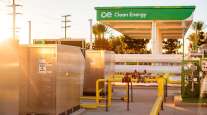Nat Gas in as Transport Fuel, But Growth Rate Uncertain
This story appears in the Jan. 28 print edition of Transport Topics.
HOUSTON — Natural gas is here to stay as a major transportation industry fuel, even as its growth path remains uncertain, according to several experts addressing a fuel conference here.
The sooner a major stakeholder decides to champion natural gas and invest heavily in it, the sooner it will get to the 20% market share that several of speakers here cited as the plateau necessary to establish natural gas as a permanent factor.
“All stakeholders are waiting for someone to make a big move,” Tom Inglesby, a partner at consulting firm McKinsey & Co., told the audience at World LNG Fuels 2013, which took place Jan. 21-23.
“We’re going to see continued growth in natural gas” as a transport fuel, he said, but the pace will depend in large part on some of the stakeholders making a major capital investment to spur growth.
He said natural gas would probably account for about 3% of total transportation fuel by end of the current decade if no champion steps forward, but it could well reach the important 20% level if one does.
Inglesby predicted that the big push for natural gas would likely come from a “big gorilla consortium” of fuel producers and distributors, or possibly from large public utilities. Currently, Clean Energy Fuels is building a natural gas network of stations at truck stops along major interstates.
Presently, vehicles powered by natural gas represent less than 1% of heavy-duty trucks in North America, held back in large part by the paucity of appropriate engines, experts told the conference.
Several new natural gas engines are due in the marketplace in the next year or two, and trucking executives have shown strong interest in the products because natural gas is considerably cheaper than diesel and burns more cleanly.
Panelists said other reasons trucking isn’t rushing headlong into natural gas include concerns about the expense of natural gas-powered trucks, the lack of fueling infrastructure around the country and the lack of history on resale prices for used natural gas trucks.
Large fleets usually turn their equipment over in three or four years and depend on good resale prices to allow them to purchase new vehicles.
“The market is unknown” for resale at this point, said Mike Juden, also an official of McKinsey & Co., and since such equipment costs substantially more than diesel-powered trucks, many motor carriers are reluctant to commit to a major overhaul of their fleets.
A number of for-hire and private fleets are testing natural gas units now, and the three companies that currently supply natural-gas engines are all developing new models.
The coming expansion of natural gas is evident in his business, said Samuel Thomas, CEO of Chart Industries, a supplier of fueling equipment. He said his current business is 75% petroleum and 25% natural gas, but his order book is composed of 40% natural gas, “and primarily LNG,” the liquefied natural gas that is expected to dominate longhaul trucking.
He said “it takes a few years” for the equipment ordered today to make it into the market mix, but that the big shift to natural gas as a transportation fuel “is happening.”
Thomas said his company, based in Ohio, has annual global sales of about $1 billion and an order book that averages around $1 billion as well.
Thomas said China “is rapidly converting” its commercial truck fleet to LNG, driven in part by the country’s lack of ultra-low-sulfur diesel. He said projections are that Chinese truck makers will produce 60,000 LNG vehicles this year, out of the 1 million trucks they will make.
He said LNG could soon account for 10% of China’s new trucks and 20% to 30% within the next few years.
Thomas said that the average extra cost of natural gas-powered trucks in the United States has declined from $30,000 to $20,000 in the past several years as manufacturing volume has increased and could be down to $10,000 in the next three years.
That price reduction will spur new sales, he said, because the payback for truck fleets would be cut from the current two to three years, owing to the lower cost of fueling the vehicles.
Several presenters at the conference, which was sponsored by Houston-based Zeus Development Corp., said they expect LNG to retain its current $1.70-a-gallon discount over diesel fuel.
At current prices, McKinsey’s Inglesby said, it takes U.S. trucking fleets about 2.8 years to recoup the extra acquisition costs of an LNG-powered Class 8 truck through the cheaper fuel.
Several speakers cited as the only potential cloud on natural gas’ horizon tighter government regulation of hydraulic fracturing, which has opened up vast natural gas reserves in the United States but has raised environmental concerns.




